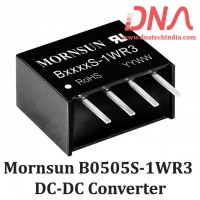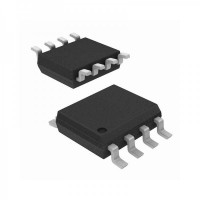Resistors in AC Circuits |
|
In the previous tutorials we have looked at resistors, their connections and used Ohm's Law to calculate the voltage, current and power associated with them. In all cases both the voltage and current has been assumed to be of a constant polarity, flow and direction, in other words Direct Current or DC. But there is another type of supply known as Alternating Current or AC whose voltage switches polarity from positive to negative and back again over time and also whose current with respect to the voltage oscillates back and forth. The oscillating shape of an AC supply follows that of the mathematical form of a "Sine wave" which is commonly called a Sinusoidal Waveform. Therefore, a sinusoidal voltage can be defined as V(t) = Vmax sin ωt. |
|
When using pure resistors in AC circuits that have negligible values of inductance or capacitance, the same principals of Ohm's Law, circuit rules for voltage, current and power (and even Kirchoff's Laws) apply as they do for DC resistive circuits the only difference this time is in the use of the instantaneous "peak-to-peak" or "rms" quantities. When working with such rules it is usual to use only "rms" values. Also the symbol used for defining an AC voltage source is that of a "wavy" line as opposed to a battery symbol for DC and this is shown below. |
|
|
Symbol Representation of DC and AC Supplies |
|
|
|
Resistors are "passive" devices, that is they do not produce or consume any electrical energy, but convert electrical energy into heat. In DC circuits the linear ratio of voltage to current in a resistor is called its resistance. However, in AC circuits this ratio of voltage to current depends upon the frequency and phase difference or phase angle ( φ ) of the supply. So when using resistors in AC circuits the term Impedance, symbol Z is the generally used and we can say that DC resistance = AC impedance, R = Z. |
|
For resistors in AC circuits the direction of the current flowing through them has no effect on the behavior of the resistor so will rise and fall as the voltage rises and falls. The current and voltage reach maximum, fall through zero and reach minimum at exactly the same time. i.e, they rise and fall simultaneously and are said to be "in-phase" as shown below. |
|
|
V-I Phase Relationship and Vector Diagram |
|
|
|
We can see that at any point along the horizontal axis that the instantaneous voltage and current are in-phase because the current and the voltage reach their maximum values at the same time, that is their phase angle θ is 0o. Then these instantaneous values of voltage and current can be compared to give the ohmic value of the resistance simply by using ohms law. Consider below the circuit consisting of an AC source and a resistor. |
|
|
|
The instantaneous voltage across the resistor, VR is equal to the supply voltage, Vt and is given as: |
|
|
|
The instantaneous current flowing in the resistor will therefore be: |
|
|
|
As the voltage across a resistor is given as VR = I.R, the instantaneous voltage across the resistor above can also be given as: |
|
|
| In purely resistive series AC circuits, all the voltage drops across the resistors can be added together to find the total circuit voltage as all the voltages are in-phase with each other. Likewise, in a purely resistive parallel AC circuit, all the individual branch currents can be added together to find the total circuit current because all the branch currents are in-phase with each other. |
|
Since for resistors in AC circuits the phase angle φ between the voltage and the current is zero, then the power factor of the circuit is given as cos 0o = 1.0. The power in the circuit at any instant in time can be found by multiplying the voltage and current at that instant. Then the power (P), consumed by the circuit is given as P = Vrms Ι cos Φ in watt's. But since cos Φ = 1 in a purely resistive circuit, the power consumed is simply given as, P = Vrms Ι the same as for Ohm's Law. |
|
This then gives us the "Power" waveform and which is shown below as a series of positive pulses because when the voltage and current are both in their positive half of the cycle the resultant power is positive. When the voltage and current are both negative, the product of the two negative values gives a positive power pulse. |
|
|
Power Waveform in a Pure Resistance |
|
|
|
Then the power dissipated in a purely resistive load fed from an AC rms supply is the same as that for a resistor connected to a DC supply and is given as: |
|
P = VR(rms) x Irms = (Irms)2xR = (Vrms)2/ R |
|
Where, |
|
P is the average power in Watts Vrms is the rms supply voltage in Volts Irms is the rms supply current in Amps R is the resistance of the resistor in Ohm's (Ω) - should really be Z to indicate impedance |
|
The heating effect produced by an AC current with a maximum value of Imax is not the same as that of a DC current of the same value. To compare the AC heating effect to an equivalent DC the rms values must be used. Any resistive heating element such as Electric Fires, Toasters, Kettles, Irons, Water Heaters etc can be classed as a resistive AC circuit and we use resistors in AC circuits to heat our homes and water. |
|
|
Example No1 |
|
A 1000W heating element is connected to a 250v AC supply voltage. Calculate the impedance (AC resistance) of the element when it is hot and the amount of current taken from the supply. |
|
Current, I = P/V = 1000W/250V = 4amps |
|
Z = V/I = 250/4 = 62.5Ω |
|
|
Example No2 |
|
Calculate the power being consumed by a 100Ω resistive element connected across a 240v supply |
|
As there is only one component connected to the supply, the resistor, then VR = VS |
|
Current, I = VR/R = 240/100 = 2.4amps |
|
Power Consumed, P = I2R = 2.42x100 = 576W |
|
|
|
Reproduced with permission from Wayne Storr |







